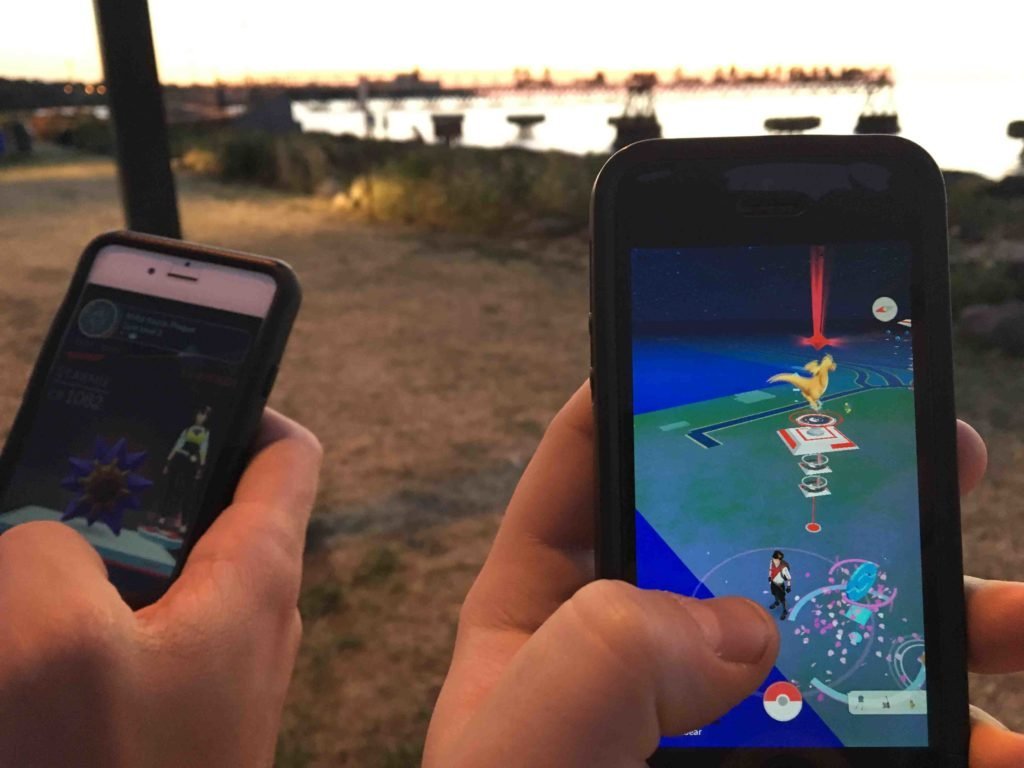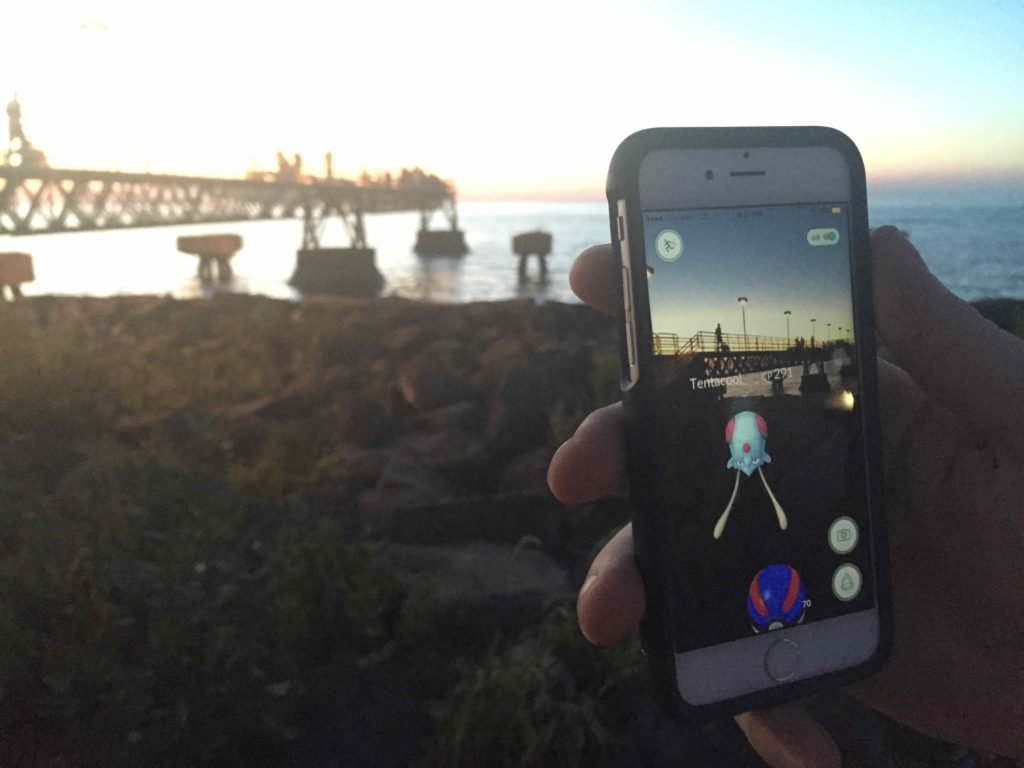Why Pokemon GO is successful: How mechanics can make a community
I know something has hit the zeitgeist once my mother starts a conversation about it, but last night showed me something more. We drove to our local park to unwind after our respective workdays, and found literal hundreds of people playing Pokemon GO. On a weeknight at 10 p.m., all of them were in packs, checking their phones. A stranger asked through our car window if we saw the Ponyta nearby, which my mom caught while I took the park's gym for my team. Our family bonding became a group activity.Pokemon GO is the zeitgeist, and the statistics don't lie. Within days, it was more downloaded than Tinder and more used than Twitter. Nintendo, who's only indirectly involved (non-majority shareholders in developer Niantic and publisher The Pokemon Company), doubled their value in 2 weeks, and had the best stock market day anyone's seen this century. GO became the most popular and highest grossing app within 24 hours. Video games are pushing into the mainstream elsewhere-- Street Fighter 5 just had tournament finals on ESPN2-- but Pokemon GO is on your Facebook wall and just down your street.

I know something has hit the zeitgeist once my mother starts a conversation about it, but last night showed me something more. We drove to our local park to unwind after our respective workdays, and found literal hundreds of people playing Pokemon GO. On a weeknight at 10 p.m., all of them were in packs, checking their phones. A stranger asked through our car window if we saw the Ponyta nearby, which my mom caught while I took the park’s gym for my team. Our family bonding became a group activity.
Pokemon GO is the zeitgeist, and the statistics don’t lie. Within days, it was more downloaded than Tinder and more used than Twitter. Nintendo, who’s only indirectly involved (non-majority shareholders in developer Niantic and publisher The Pokemon Company), doubled their value in 2 weeks, and had the best stock market day anyone’s seen this century. GO became the most popular and highest grossing app within 24 hours. Video games are pushing into the mainstream elsewhere– Street Fighter 5 just had tournament finals on ESPN2— but Pokemon GO is on your Facebook wall and just down your street.
“Why” has a counter-intuitive answer. Pokemon GO is the epitome of a trend, one which recognizes that while people aren’t inherently evil, it’s easier for them to be selfish. This is the kind of game that wants to bring people together, and one would expect Niantic to reward the social, and punish the antisocial. But instead, Pokemon GO is so popular because it throws out moralism altogether. Nothing is necessarily gained or lost by however you choose to play with others, and in that situation, most people play nice anyway. Pokemon GO is a fascinating response to problems the entire game industry has struggled with since its inception.

Some context: These are the dying days of playing games with someone sitting next to you. They’re losing their physical presence just as much as literature is. Video games have been social since Pong, and that socializing has always been limited. You’re not having meaningful discourse with your enemies, and you rarely do more than strategize with, compliment, or …”critique” your teammates. People discuss single-player games, but that isn’t exceptional from other storytelling mediums.
The real problem is the gaming community. “Gamers” are stereotyped as “hardcore” or “casual.” If you like a movie, and someone accuses you of “entry-level knowledge” about it, the average moviegoer would call that person an asshole. But you can basically expect it joining most gaming communities. The “average” gamer is how companies talk about “hardcore” gamers, the ones who they hear from most. And then there are the types that send developers death threats for delaying a game two months.
Playing further into that community division, there’s the execution barrier. In poker, you can bluff and raise with a word. In Street Fighter 5, try to recognize, let alone pull off, a jump-in high kick, medium kick, high kick, right, down-left, right, high punch into EX Shoryu OR confirm into Ultra on a 5-frame wakeup. That’s an actual, and fairly basic, 4-hit “b&b” (bread and butter) combo— meaning you should be able to pull it off mid-fight, at will. And if you’re spectating, you have to know this flurry isn’t button-mashing, and know what it represents.
You don’t have to understand the plays to enjoy watching football, but unless you do actual research, watching high-level competitive games is usually a frenetic mess. And this isn’t an outlying problem for games– remember, Street Fighter 5 was just on ESPN2. This is one of the mainstream ones.
It’s not like video games are the only medium with an antisocial problem though. Facebook and other massively social media often reward pithy comments more than personal messages. Most aren’t as successful for making friends as they are for connecting with current ones, and if you’re going to communicate with a stranger, it’s usually not going to be through a conversation, it’s going to be a like on a comment on a meme.
So how can a game like Pokemon GO offer a gaming and social experience nothing else can?
Pokemon is a cultural touchstone; everyone knows Pikachu. Pokemon GO realized, brilliantly, that this allows divergent in-game experiences still immediately recognizable to other players. If you saw a coyote on the way to work and I saw a fox, we’d talk about it. Now say you caught a Growlithe, and I caught a Vulpix. Same idea.
Even without cultural standing, the game’s incredibly accessible. Catching Pokemon is simple, but dramatized to be fun. Pokemon get Combat Point ratings, but also XL or XS size and weight, so if combat doesn’t interest you, collect cute or swole ‘mon. Gym battles are simple taps, holds, and swipes; they’re kind of broken, but anyone can get into them. And the “Candy” system keeps players catching redundant Pokemon. Even once you’ve caught them all, you can always catch more to power up.
And simply put, Pokemon GO’s limited systems are its greatest social impact.
Pokemon GO forces you to communicate. The poor tutorial pushes real-world communication about how the systems work. This led to discoveries, like forcing Eevee evolutions, and even how to throw the ball well. In a similar way, once you figure out how to play, the awful ‘nearby’ tracking is, perhaps, intentional. The game places PokeStops at exact locations, but only gives you ambiguous paw prints as a distance marker for Pokemon. The vague tracker forces you to get lost and, presumably, group up and explain where that Ryhorn is hiding.
The game rewards foot-traffic through busy spaces. Pokemon locations will refresh when standing still, but you’ll find many more by traveling. Movement improves Incense’s efficacy, for instance. But mainly, Eggs hatch some rare Pokemon and practically spill Candy, but they require almost a daily walking regimen to meet the 2-10 km requirements.
You can buy most items, but the only way to get some (and the only free way to get others) is PokeStops. They’re concentrated in busy areas as designated by Niantic’s previous game Ingress, and because which items and how many you get are randomized, you’ll need to hit a few to get what you need. You can wait for one to refresh, but walking to the next is more efficient.
And cars aren’t going to help you. Any movement above bike speed won’t contribute to Egg hatching, and because of server delay, you’re usually too far from Pokemon or PokeStops to activate them by the time the game loads them in.
Pokemon GO necessitates being around people for its best sedentary features. Gyms require proximity, and when you fight a Gym, you can see any other Pokemon fighting with you. To take or hold a Gym usually requires a few people training there or attacking a Gym at the same time, also in close proximity– fighting a 10-Pokemon Gym over and over drains too many items.
The teams are a mixed bag, because some people will always overdo competitiveness, but it’s a motivator: Help YOUR team at gyms. There are only 3 teams, so not as binary as other games, but still simple enough that people can care. And teams can be ignored if you just want to catch Pokemon.
Lure’s are inspired. They’re the only sign a player has on their map of other players’ present activity, and it has to be used at a PokeStop, usually a busy area. With the Lure helping everyone around catch more Pokemon, people gather.
Most importantly: Pokemon appear in the same place for you as for other people, but you can still all catch the same Pokemon in the same spot. You haven’t played Pokemon GO until you’ve seen 30 people pour out of several nearby bars at 12:30 a.m. to catch a Bulbasaur.
What this all means is that when you and a stranger walk to the same spot with your phones out, you can laugh about trying to catch the same Pokemon, then ask what team they’re on. And the community can choose how seriously to take itself: Whether you answer that you’re on red/yellow/blue team or team Valor/Instinct/Mystic is a decent initial indication of how much you care, especially because most people’s team choice was spur-of-the-moment.
Full disclosure: Red is my favorite color, Zapdos is my favorite bird, and Mystic is my favorite team name. The choice was hard.
But you by no means have to interact with others. Coast off other people’s Lures. Chip away at Gyms, snipe empty ones, train on your own. Defend elementary school gyms, or take them down Team Rocket style. And get the same XP. Once, I passed a bar with CP700 Pokemon fighting for power. So I slipped in my CP1500 Dragonite. The roar as I walked away was life-affirming. Trading is coming, but even it won’t be necessary to success— someone’s already caught them all (that are available in North America).
But most people are friendly. I saw people I haven’t seen in over 4 years while out. I met strangers who appreciated a “Hey,” or appreciated when I left it at that. I crossed my city twice with a friend to catch up and hunt Pokemon, and I’ve ignored friends to ensure that I caught a Tauros. And none of those decisions, good or bad, directly affected my game.
Future updates may allow more player interaction with more benefits, but as it stands, you can play however you feel in a moment— wandering and staying in your own head, or tossing banter around a gazebo with 3 Lures around it, asking who caught the Haunter that just showed up.
As they say, you can lead a horse to water, but you can’t make him drink. Pokemon GO treats social interaction like that water: Lead a bunch of people to the same place with the same thirst (to play Pokemon, but, really, to love Pokemon), and leave them to their own devices. This isn’t always an innocent process. Some people have committed robberies with GO, some have felt unsafe playing GO, some have begun sticking VR Pokemon in unfortunate situations.
But for the most part, it’s just made people’s daily lives better. I taught my mother how to play, and I helped her get her first starter, and I lied about last night: She didn’t catch the Ponyta, I helped her catch it, and then we thanked the stranger for the tip. Pokemon GO doesn’t ask us to behave a certain way, it just gives us a shared reason to go outside and be people. It just so happens that most people want to be good.
